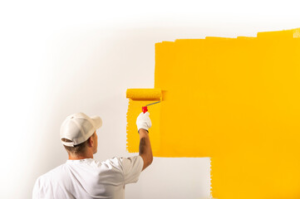Professional house painters offer value-added services beyond just slapping on a fresh coat of paint. They can transform homes into representations of their owners’ personalities, keep homeowners on the good side of their HOA, and reduce the risk of mold growth in areas prone to humidity.

House painters have expert knowledge of various paint brands and their durability. They also know how to apply caulk and putty and use clean-up materials to protect floors and furniture. Visit louspaintingcompany.com/ to learn more.
A small painting contractor company works with a team of house painters to complete projects. They offer competitive prices and guarantee their work. They usually provide a written estimate of costs and expected completion date. They also supply references from previous clients. A quality painting company should carry liability and workers’ compensation insurance. If a worker falls off a ladder or scrapes up your carpet, you need to be protected.
A house painter business can be run as a sole proprietorship or partnership. Both types have their advantages and disadvantages. If you operate as a sole proprietorship, you’ll need to register your business name with the local government. You’ll also need to obtain a license and buy equipment. You may need to get a credit card for business expenses and hire an accountant to manage bookkeeping.
You can market your house painting services with business cards, flyers and magnets. Post them on bulletin boards at home improvement and grocery stores, and distribute them in your neighborhood. Ask happy clients to recommend you to their friends and family. You can also use a field service CRM to track client referrals and follow-up.
If you’re targeting a specific industry, such as hospitality companies, you can attend networking events, conventions and trade shows. You can meet other business owners and carpenters who might have a need for your services. You might be able to subcontract with them on larger jobs or establish relationships that lead to new contracts for your business.
Creating a Google Business Profile is one of the simplest ways to establish an online presence and start attracting customer leads. The free listing displays your business contact information, photos, reviews and frequently asked questions when potential customers search for painting businesses on Google. You can also promote your business with Google Ads, which target specific keywords and demographics. Having an online presence can help establish your credibility as a painter and make you more likely to win jobs. In addition, you can increase your visibility in the search engine results pages (SERPs) with targeted ads based on your location, budget and objectives.
Large Companies
Painting seems like an easy enough DIY project to undertake, but professional local house painters are experts in the process of taping off, priming, and applying multiple coats of paint. The resulting work will last many years and transform your living space. They will also know the right materials to use and the proper techniques to ensure your walls and ceilings are smooth and ready for your new wallpaper or paint color.
It takes a lot of time and money for a legitimate painting company to recruit, screen, hire, and train high-quality professional painters; to adhere to the Painting & Decorating Contractors of America standards of workmanship; and to maintain adequate insurance levels and workers’ compensation policy premiums. This all adds up to a higher bid price for the customer, but it is worth the peace of mind that comes with knowing your painting company will be there for you when you need them.
Some of these larger companies have been in business for a long time and can be trusted to deliver quality results. They may have a wide range of services available to you, including power washing and stain removal, wallpaper installation or removal, drywall repair, plastering, skimming, and minor carpentry. They will also provide a free estimate before starting the job.
Other large painting companies may specialize in certain types of jobs. For example, a painter who is well-versed in commercial painting will be able to handle large offices and industrial buildings with tall ceilings. These painters may even be able to complete the job more quickly than a homeowner who attempts to take on the task by themselves.
A few of these larger companies have websites that are easy to navigate and clearly explain their services. For example, the Phinney Ridge Painting website includes pictures of past projects and excellent reviews to attract customers. In addition, the site uses a clear font to help visitors scan through the information quickly. This is an effective strategy to keep potential clients engaged and interested. The company is also ranked high on search engine rankings.
One-Man-Shows
A house painter is in the business of helping their clients make their homes look beautiful by applying a fresh coat of paint. They use brushes, rollers and sprayers to apply a variety of different finishes. Some house painters also specialize in certain styles, such as faux or textured painting. Some painters even offer interior design services to help their clients choose color schemes and furniture for their home makeover.
Some house painters are one-man-shows that work on their own. They usually get their business through word of mouth, friends and family. They may have a website that lists their services and contact information. Many of these painters are licensed and insured, and can provide a list of previous clients for reference.
These painters are able to take on jobs of all sizes, and typically have their own tools and vehicle. They can be a great choice for small, quick projects, such as repainting an accent wall. However, if you have a large project or are looking for a company that has experience with commercial or residential projects, a larger, professional painting company may be your best option.
Professional painters are able to finish projects much faster than homeowners who do the work themselves. They are able to work more efficiently, and will be able to complete the entire job within a few weeks. They will also be able to spot and fix issues, such as uneven walls or loose trim, that an amateur might miss.
While some painters choose to work alone, others work with a partner or two, or even a full crew. While working with a team can be more expensive, it is often worth the investment. Professionals will be able to complete your project faster, and can usually work around your schedule. They will also be able to handle the task of moving heavy furniture out of the way, and will have the proper tools to do so safely.
If you hire a professional house painter, it is customary to leave them a tip. This is usually in the form of cash, although some people prefer to give a gift card or small item as a show of appreciation. However, it is important to consider the painters’ preferences when deciding whether to tip them.











